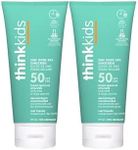Buying Guide for the Best Sunscreen For Kids
Choosing the right sunscreen for kids is important to protect their sensitive skin from the harmful effects of the sun. Kids' skin is more delicate and can burn more easily than adults', so it's essential to pick a sunscreen that offers effective protection, is gentle, and is easy to apply. When shopping for sunscreen, focus on understanding the key features that make a sunscreen suitable for children, and consider your child's specific needs, such as skin sensitivity, activity level, and how long they will be outdoors.SPF (Sun Protection Factor)SPF measures how well a sunscreen protects the skin from UVB rays, which are the main cause of sunburn. The higher the SPF number, the greater the level of protection. For kids, SPF 30 to 50 is generally recommended. SPF 30 blocks about 97% of UVB rays, while SPF 50 blocks about 98%. If your child will be outdoors for extended periods or has very fair skin, a higher SPF may be more suitable. For everyday use or short outdoor activities, SPF 30 is usually sufficient. Always reapply sunscreen every two hours, regardless of SPF.
Broad-Spectrum ProtectionBroad-spectrum sunscreens protect against both UVA and UVB rays. UVA rays can cause long-term skin damage and premature aging, while UVB rays cause sunburn. It's important to choose a sunscreen labeled as 'broad-spectrum' to ensure your child is protected from both types of rays. This is especially important for kids who spend a lot of time outdoors, as both types of rays can be harmful.
Water ResistanceWater resistance indicates how long the sunscreen will stay effective when your child is swimming or sweating. Sunscreens are usually labeled as water-resistant for either 40 or 80 minutes. If your child will be swimming or playing sports, choose a sunscreen with higher water resistance. Remember, no sunscreen is completely waterproof, so it's important to reapply after swimming, sweating, or towel drying.
Type of Ingredients (Mineral vs. Chemical)Sunscreens use either mineral (physical) or chemical ingredients to protect the skin. Mineral sunscreens use ingredients like zinc oxide or titanium dioxide, which sit on top of the skin and reflect UV rays. These are often recommended for kids, especially those with sensitive skin, because they are less likely to cause irritation. Chemical sunscreens absorb UV rays and may be lighter in texture, but some children may react to certain chemical ingredients. If your child has sensitive skin or allergies, a mineral sunscreen is usually the safer choice.
Application Form (Lotion, Stick, Spray)Sunscreens come in different forms, such as lotions, sticks, and sprays. Lotions are easy to spread and ensure even coverage, making them a good choice for most kids. Sticks are convenient for the face and hard-to-reach areas, and they are less likely to run into the eyes. Sprays are quick to apply but can be harder to control and may not provide even coverage unless rubbed in. For younger children, lotions or sticks are often best, while older kids may prefer sprays for convenience, as long as they are applied properly.
Hypoallergenic and Fragrance-FreeKids' skin can be sensitive to fragrances and certain chemicals, which can cause irritation or allergic reactions. Choosing a sunscreen labeled as hypoallergenic and fragrance-free can help minimize the risk of skin problems. This is especially important if your child has a history of eczema, allergies, or sensitive skin. Always do a patch test on a small area of skin before using a new sunscreen all over.















